
Aurora is a city in northeastern Illinois, United States, located along the Fox River. The population was 180,542 at the 2020 census. It is the second-most populous city in Illinois, after Chicago, and the 144th-most populous city in the US. Aurora is the largest city in Illinois that is not the county seat of any county that it resides in.

Galena is the largest city in and the county seat of Jo Daviess County, Illinois, United States. It had a population of 3,308 at the 2020 census. A 581-acre (235 ha) section of the city is listed on the National Register of Historic Places as the Galena Historic District. The city is named for the mineral galena, which was in the ore that formed the basis for the region's early lead mining economy.

Orangeville is a village in Stephenson County, Illinois, United States. The town's sign lists the population at 800 as of January 2021. The population in 2020 was 738. The population according to the 2010 census was 793, up from 751 in 2000. Using the 2020 population of 738 Orangeville is the 741st largest city in Illinois and the 11,650th largest city in the United States. Orangeville is currently declining at a rate of -0.94% annually and its population has decreased by -6.94% since the 2010 census. The area's earliest white settlers arrived in the year 1833, and the village was platted in 1851 by John Bower, who is considered the village founder. In 1867 Orangeville was incorporated as a village. The town's central business district contains several 19th century commercial buildings, many of which were built during the railroad boom of 1888–1914. By the time the Great Depression was ongoing, business in Orangeville had started to decline, with the last bank closing in 1932. In 1956 another bank started operating in the village and is still in town today. Some recent infrastructure jumps have restored some of the village's old decor.

Rockford is a city in Winnebago County, Illinois, United States. Located in far northern Illinois on the banks of the Rock River, Rockford is the county seat of Winnebago County. The population was 148,655 at the 2020 census, making Rockford the fifth-most populous city in Illinois, as well as the state's most populous city outside of the Chicago metropolitan area. It anchors the Rockford metropolitan area, which had 338,798 residents in 2020.

The Chick House is a former hotel building constructed in 1857 in the city of Rockford, Illinois, United States. The building's construction was financed by three Rockford citizens and it operated as a hotel from its opening until 1951. The hotel was purchased by Thomas Chick in 1888 and he renamed it from the Griggs House to the Chick House. In 2004 the city of Rockford purchased two-thirds of the building and made some modifications to the structure. The building is a mesh between the Greek Revival and Italianate styles and feature simple ornamentation that contrasts with a neighboring building. The Chick House is a Rockford Landmark and was listed on the U.S. National Register of Historic Places in 1997.

The Galena Historic District is a historic district located in the city of Galena, Illinois, United States. The historic district encompasses 85 percent of the city of Galena and includes more than 800 properties. The downtown area consists of three successive tiers made up of Main, Bench and Prospect Streets. Within the boundaries of the district are such notable homes as the Ulysses S. Grant Home and the Elihu B. Washburne House. The Galena Historic District was added to the U.S. National Register of Historic Places in 1969.
The Galena–Chicago trail was a stagecoach route located in northern Illinois that ran from the mid-to-late 1830s until 1854. As indicated by its name, the route linked Chicago, located in the northeast of the state, with Galena which was located in the lead mining district of the northwest. The Chicago-Galena trail includes the "Stagecoach Trail" that runs between Galena and Lena, Illinois. East of Lena the stage route follows U.S. Route 20 and Business U.S. Route 20 through Eleroy, Freeport and Rockford to Belvidere. This road began as the old State Road number 2 established on 15 January 1836 and laid out by June 1837.

Stolp Island is a small island in the Fox River in Aurora, Illinois. In 1986 the island and its 41 buildings were added to the National Register of Historic Places as the Stolp Island Historic District. It covers 0.03 square miles (0.1 km2) of land area.

The Spring–Douglas Historic District is a set of 496 buildings in Elgin, Illinois. Of those, 455 buildings contribute to the district's historical value. It is a residential district following Spring Street and Douglas Avenue from Kimball Street in the south to River Bluff Road to the north. The lands that now comprise the district were originally settled by Phineas J. Kimball and Vincent Lovell in the 1830s. Kimball's property eventually became the southern part of the district, which mostly housed working-class citizens. Lovell's subdivisions became housing for wealthier managers and doctors. The lower district is noted for its vernacular architecture, mostly gablefront houses, while the upper district represents a wide array of late 19th and early 20th century styles, mostly Queen Anne.
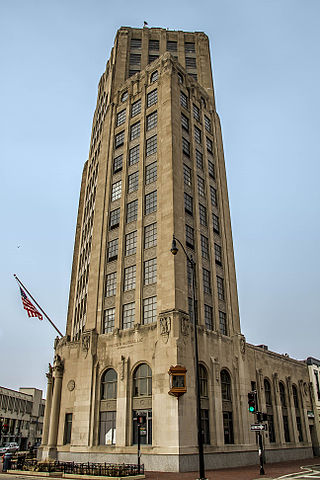
The Elgin Tower Building, originally the Home Banks Building, is a historic office building in downtown Elgin, Illinois. The tower is 186 feet tall and 15 stories. It was built in 1929 to house the Home National Bank and Home National Savings and Trust. Though initially successful, the Great Depression devastated the bank only months later. The tower was again prosperous following World War II, when demand for Elgin goods increased. However, this prosperity was only temporary, and the tower again fell on hard times in the 1960s, particularly after the 1965 closing of the Elgin National Watch Company. The tower was eventually purchased by William R. Stickling, who went to great lengths to restore it. It was donated to a charity named in his honor following his 1999 death, and the William R. Stickling Charitable Foundation continues to maintain the structure. Its restoration is considered a major part of a hopeful rehabilitation of downtown Elgin. The tower is one of only two Art Deco buildings in Elgin and was added to the National Register of Historic Places in 2002. An elevator in the building that had a wooden interior was destroyed by arson on May 4, 2014. The building was then purchased in 2016 by Capstone Development and renovated into apartments.

The Moline Downtown Commercial Historic District is a nationally recognized historic district located in Moline, Illinois, United States. Centered on 5th Avenue, it is roughly bounded by 12th Street to 18th Street, 4th Avenue to 7th Avenue. The distinct covers 33-acre (0.13 km2) and includes 114 buildings. One hundred of the buildings contribute to the significance of the district because they retain their historic and architectural integrity and reflect the character of the historic downtown.
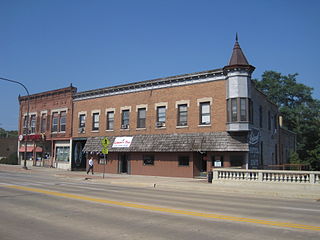
The Belvidere North State Street Historic District is a historic district on the north side of the Kishwaukee River in Belvidere, Illinois. It is primarily composed of commercial building representative of architectural trends from 1865 to 1962. The district has remained largely intact since the mid-1930s.
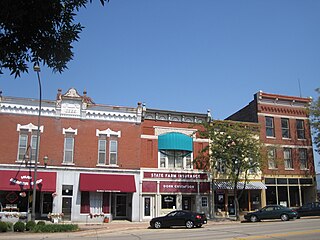
The Belvidere South State Street Historic District is a historic district on the north side of the Kishwaukee River in Belvidere, Illinois. It is primarily composed of commercial building representative of architectural trends from 1852 to 1962, the period following the connection of the city to the Galena and Chicago Union Railroad.

Peacock Brewery, also known at times as the Rockford Brewing Company and the Rock River Brewing Company, is a historic pair of buildings on the east side of the Rock River in Rockford, Illinois, United States. It was Rockford's largest brewery for almost seventy years.

Greenwood Cemetery is a 100-acre (40 ha) cemetery in Rockford, Illinois. Founded in 1852, it is the largest and oldest in the city. The Greenwood Cemetery Chapel and Crematory was listed on the National Register of Historic Places.

The East Rockford Historic District is a historic commercial area of Rockford, Illinois, United States.
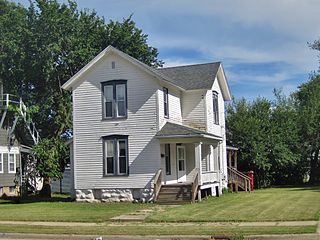
The Garrison–Coronado–Haskell Historic District is a largely residential historic district in Rockford, Illinois, United States. Nearly half of the district is houses built between 1890 and 1900. 503 of its 564 buildings contribute to the district's historic fabric. George Haskell and Thomas Garrison were two of the earliest developers of the residential west side. The Garrison School and Valencia Court Apartments are part of the district.
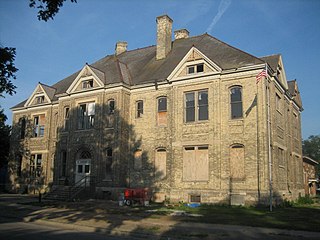
The Garrison School is a historic school building in Rockford, Illinois, United States. The oldest surviving school building in the city, the original building opened in 1887.

The William Brown Building is a historic commercial building in Rockford, Illinois, United States. Completed in 1892, it is considered a fine local example of Romanesque Revival architecture. It was one of the last major commercial buildings in Rockford between the Panic of 1893 and the Roaring Twenties.





















